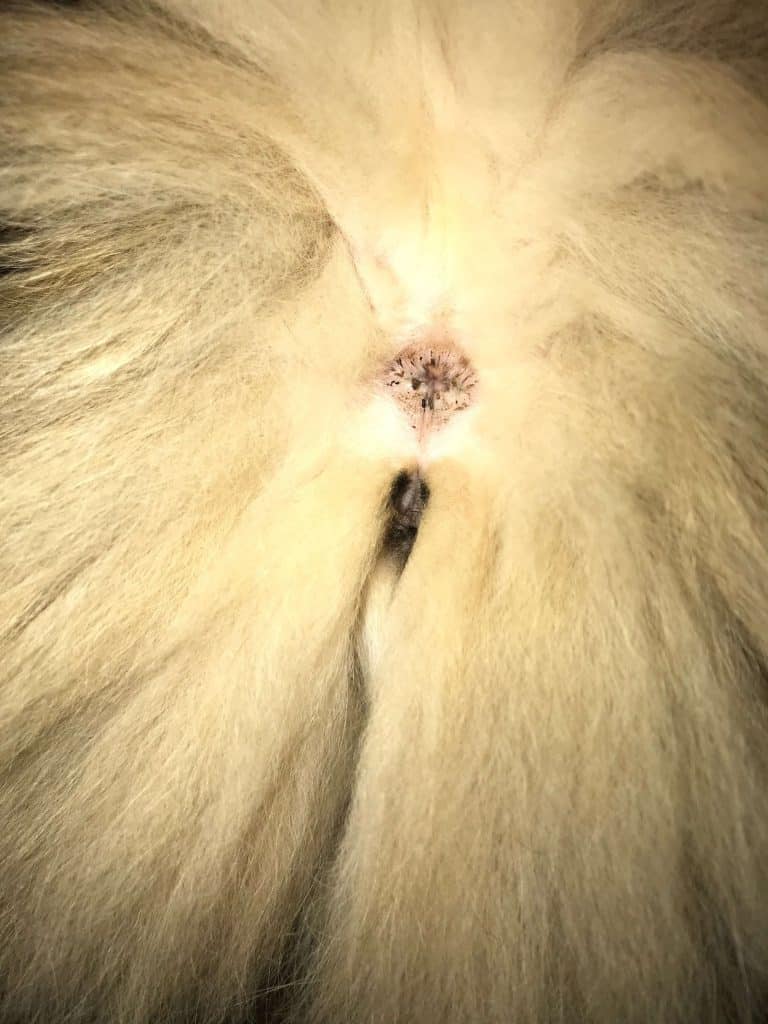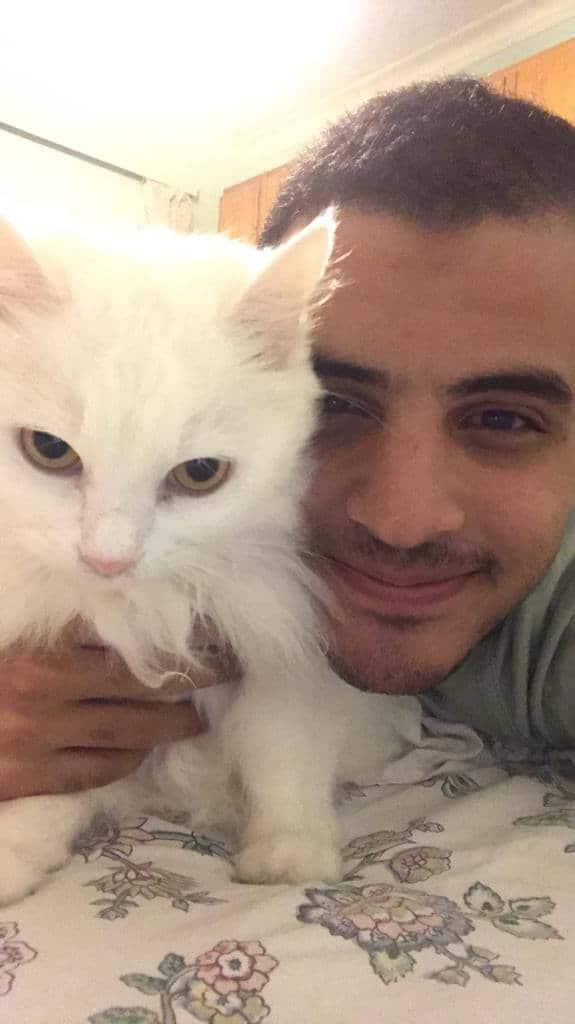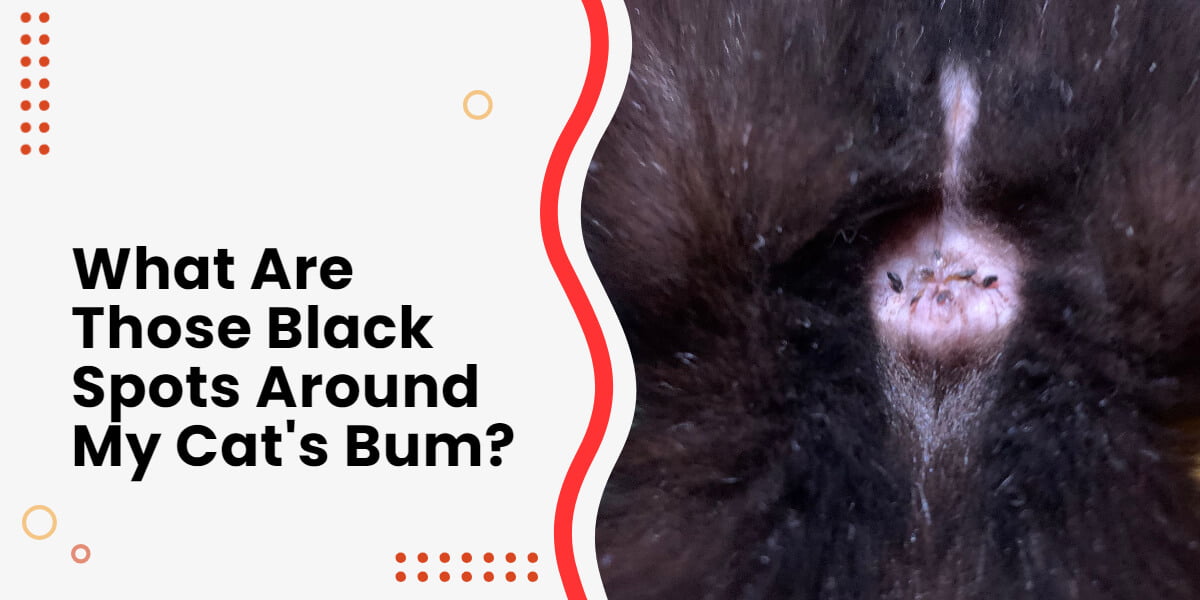Anyone who’s adopted, or let’s be real here, been adopted by a cat, knows how independent they are. Unlike dogs, cats generally need less attention from their parents. But knowing that isn’t enough to stop us cat parents from obsessively checking that our favorite felines are in good shape.
A common problem cat owners come across is finding black seed-like spots around their cat’s bum. Well, we’ve got you covered with this article. As we proceed, we’ll tell you all the different reasons to find black beads around a cat’s bum.
Table of Contents
What Are the Black Beads Around Cats Bum?
The black beads around a cat’s bum are usually small flecks of dried feces or debris stuck in the fur. This is commonly referred to as “dingleberries”. Dingleberries themselves are harmless, but can also be a sign of an underlying health issue. Other potential causes of black spots around the rear include flea dirt, tapeworm segments, impacted anal glands, and abscesses.
To determine the cause, check for other symptoms like scooting, excessive licking of the area, or changes in litter box habits. If your cat is acting normally otherwise, gently clean the area and monitor. Seek veterinary advice if additional symptoms arise. Keeping the fur around the rear trimmed can help prevent dingleberries from forming.
Here are the most common causes

We can’t deny that these little black beads are an inconvenience to your furry pal, so let’s go over the potential causes.
Anal Gland Disease
These glands are found near the anal opening. They secrete chemicals that act as territorial markers, drive off predators, and alert other animals to their presence. Small amounts of these secretions are usually forced out by muscular contractions whenever the cat poops.
A problem arises if the openings of these glands become blocked, possibly by feces. The secretions will accumulate inside the glands. And the bacteria present in the feces would act on them, triggering an inflammatory reaction. This inflammation appears as an itchy, red perianal area.
Well, how do I know that my cat is feeling itchy?
You might notice your cat is repeatedly licking or scratching itself. Another unusual behavior that cats show is dragging their bum across the floor. During this stage, the management consists of squeezing the secretions out of the glands along with topical antibiotics and anti-inflammatory drugs.
If not treated early, inflamed anal glands can turn into an abscess, which would require surgery. Like any surgery, this procedure carries the risks of general anesthesia.
Another problem that can arise after surgery is incontinence, resulting from injury to the anal sphincter. While the majority of cases improve within a few weeks after surgery. Some cats remain incontinent and require special diapers.
Related: Why Does My Cat’s Hair Look separated?
Cat Fleas (Ctenocephalides Felis)
While they aren’t the only flea types found on domestic cats, they’re the most common and sadly the hardest to get rid of. Cat fleas are known to carry many diseases, making them a danger to your cats as well as yourself.
But how can you detect your cat’s flea infestation?
If you notice your cat scratching or biting its fur persistently, you should consider if it might be suffering from a flea infestation.
You can see the fleas —as small black moving spots— or their feces —as pepper-like black spots— on your cat’s fur coat. Fleas are usually present at the base of the tail or the cat’s armpits.
Recommended: Here’s why your cat’s losing hair on the tip of its tail
Cat fleas secrete digestive enzymes onto the cats’ fur and skin, to which some cats can be allergic. This allergic reaction can appear as severe itching, bald patches, red skin, and secondary infections.
If your pet is diagnosed with a cat flea infestation, then you need to treat both your pet and your home simultaneously.
You can de-flea your pet using oral or topical anti-flea drugs. As for your home, thorough cleaning and excessive sunlight should do the job. Remember, fleas love warm and moist environments, so make sure that your home is nothing of the sort.
Tapeworms
Your cat can get infected by tapeworms in two ways. Either through fleas or by eating an animal that is infected by tapeworms, like rats or squirrels.
Tapeworm infections are generally symptomless, but you can suspect your pets’ infection if you find some subtle signs. Like excessive itching at the anal area, if your pet vomits worms, or if you find sesame-seed-like spots on your cat’s bum.
If your pet has been diagnosed with tapeworm infection. Your vet would probably offer treatment in the form of injection, oral, topical medications, or a combination of them.
Now, you’re probably wondering if you can get infected by tapeworms. It’s unlikely, but yes, humans can get infected if they eat the proglottids —the sesame-seed-like spots— that your pet would pass along with their poop.
Tapeworm infections in humans are, although rare, generally affecting children as they’re the ones more prone to put dirty objects or hands in their mouths.
Recommended: Here are the reasons behind the little poop nuggets your cat leaves around the house
Dingleberries
Not a disease. Dingleberries is a term used to describe spots of dried poop that might stick to your cat’s fur. This is especially common with long-haired cats that suffer from loose stools.
While dingleberries themselves aren’t dangerous, they might hint at another problem like diarrhea that you might want to get checked.
It is generally better not to interfere with your cat’s business. Being clean and remarkably flexible, cats can properly clean themselves. However, there are certain situations when lending a helping hand —literally —might be most welcomed, like:
- When their poop is extra soft making it annoyingly sticky.
- Overweight cats might have difficulty reaching their butts
- Elderly cats might suffer from arthritis, which makes them less flexible and unable to bend enough to clean themselves properly.
You can clean your cat’s bum using a wet cloth or baby wipes and wipe gently till you get all the dried feces off.
Treating Black Beads Around Your Cat’s Bum
If you notice black beads around your cat’s bum, the first step is to identify the underlying cause. Here are some tips for treating common causes:
- Anal Sac Disease – See your vet for treatment. They may express the anal sacs, prescribe antibiotics and anti-inflammatory medication. In severe cases, surgery may be required. Keep the area clean.
- Fleas – Treat your cat and home with flea medication prescribed by your vet. Vacuum and wash bedding regularly.
- Tapeworms – Deworming medication prescribed by a vet will kill off tapeworms. Be sure to treat any flea problems as well since fleas can transmit tapeworm eggs.
- Dingleberries – Gently clean your cat’s rear with a warm wet cloth or cat-safe wipes. Comb out matted fur. Increase fiber in diet to firm stools if chronic issue.
Signs of Anal Sac Problems
Anal sac problems like impaction and infection can cause your cat discomfort. Signs include:
- Black crusty discharge around the anus
- Straining to defecate
- Scooting bottom along the floor
- Excessive licking or biting at the anal area
- Anal sac abscess – a painful swollen lump on one side of the anus
See your vet promptly if you notice these signs of anal gland issues. Treatment may include manual expression, antibiotics, and surgery for recurring problems.
Hair Loss Around the Anus
It’s normal for cats to have a small bald spot right above the anus. However, excessive hair loss around the rear can signal an underlying problem. Potential causes include:
- Flea allergy dermatitis – itchy reaction to flea bites leads to overgrooming
- Food allergy – itchy skin drives overgrooming of the base of tail and rear. You can check our list of favorite z/d cat food alternatives that are perfect for allergies.
- Anal gland issues – licking and biting at the irritated anal area
- Tapeworms – itching around the anus from tapeworm segments exiting
See your vet to pinpoint the cause. Treatment will focus on resolving the underlying issue, whether it’s fleas, allergies, parasites or anal gland problems.
Conclusion
Although you shouldn’t be alarmed if you find black beads around your cat’s bum, this should remind you to observe your cat for any cues of a problem carefully. These cues can be excessive grooming or your cat dragging its bum on the floor. If you find anything of the sort, you should take your cat to the vet as soon as possible for a check-up.
Now that you’ve read our article, you have an overview of all the reasons your cat might have black beads on its bum. You also know the important signs you should be looking for, And what to expect if your cat has been diagnosed with any of the diseases we’ve mentioned.

I’ve been living with cats since 2008 and I can confidently say I have more feline friends than humans lol. I currently live with 5 cats in different life stages; two of them are less than one year old, one is 2-ish years old and the oldest two are 9-ish years old. I’ve developed a strong bond with cats over the years and I’m eager to share my experience through this blog. You can learn more about my cats here.


